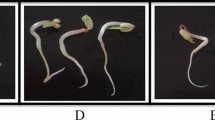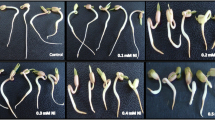Abstract
The present study investigated the effect of Arsenic (As; 5, 10, 50 μM) on protein and sugar metabolism vis-à-vis oxidative damage during early germination process and radicle emergence (at 12, 24 and 48 h stage) in Phaseolus aureus. As-exposure (50 μM) significantly enhanced protein content (by 40–60%), whereas carbohydrate content declined (by 31–44%) over that in the control. It was associated with a decline in the activities of proteases (47–53%), and increase in the activities of α- and β-amylases, starch phosphorylases, and acid invertases by 3.0, 2.6, 4.8, and 1.7 times after 48 h exposure to 50 μM As. The alteration in protein and carbohydrate metabolic machinery was also accompanied by As-induced reactive oxygen species (ROS)-mediated oxidative damage. As treatment enhanced malondialdehyde and hydrogen peroxide content by 46–252% and 23–216%, and hydroxyl and superoxide ion generation by 15–104% and 17–278%, respectively. As-induced lipid peroxidation and membrane disruption was confirmed by enhanced electrolyte leakage (by 49%) and reduced cell viability (by 43%). Furthermore, in response to 50 μM As, the activities of superoxide dismutases, catalases, ascorbate peroxidases, guaiacol peroxidases, and glutathione reductases increased by 77%, 70%, 116%, 43% and 120%, respectively, in radicles at 48 h stage over that in the control. The study concludes that As inhibits radicle emergence and elongation in germinating P. aureus seeds by altering biochemical processes related to sugar metabolism and inducing an ROS-mediated oxidative damage.

Similar content being viewed by others
References
Mahimairaja S, Bolan NS, Adriano DC, Robinson B (2005) Arsenic contamination and its risk management in complex environmental settings. Adv Agron 86:1–82
Naidu R, Bhattacharya P (2009) Arsenic in the environment – risks and management strategies. Environ Geochem Health 31:1–8
Williams PN, Villada A, Deacon C, Raab A, Figuerola J, Green AJ, Feldmann J, Meharg AA (2007) Greatly enhanced arsenic shoot assimilation in rice leads to elevated grain levels compared to wheat and barley. Environ Sci Technol 41:6854–6859
Polizzotto M, Kocar BD, Benner SG, Sampson M, Fendorf S (2008) Near surface wetland sediments as a source of arsenic release to ground water in Asia. Nature 454:505–508
Lou-Hing D, Zhang B, Price AH, Meharg AA (2011) Effects of phosphate on arsenate and arsenite sensitivity in two rice (Oryza sativa L.) cultivars of different sensitivity. Environ Exp Bot 72:47–52
Smith E, Naidu R, Alston AM (1998) Arsenic in the soil environment: a review. Adv Agron 64:149–195
Hartley-Whitaker J, Ainsworth G, Meharg AA (2001) Copper and arsenate induced oxidative stress in Holcus lanatus L. clones with differential sensitivity. Plant Cell Environ 24:13–22
Stoeva N, Berova M, Zlatev Z (2005) Effect of arsenic on some physiological parameters in bean plants. Biol Plant 49:293–296
Singh HP, Batish DR, Kohli RK, Arora K (2007) Arsenic-induced root growth inhibition in mung bean (Phaseolus aureus Roxb.) is due to oxidative stress resulting from enhanced lipid peroxidation. Plant Growth Regul 53:65–73
Meharg AA (2003) Variation in arsenic accumulation—hyperaccumulation in ferns and their allies. New Phytol 157:25–31
Singh HP, Kaur S, Batish DR, Sharma VP, Sharma N, Kohli RK (2009) Nitric oxide alleviates arsenic toxicity by reducing oxidative damage in the roots of Oryza sativa (rice). Nitric Oxide 20:289–297
Ma B, Wan J, Shen Z (2007) H2O2 production and antioxidant responses in seeds and early seedlings of two different rice varieties exposed to aluminum. Plant Growth Regul 52:91–100
Van den Broeck K, Vendecasteele C, Geuns JMC (1998) Speciation by liquid chromatography-inductively coupled plasma-mass spectrometry of arsenic in mung bean seedlings used as a bio-indicator for the arsenic contamination. Anal Chim Acta 361:101–111
Sheppard SC (1992) Summary of phytotoxic levels of soil arsenic. Water Air Soil Pollut 64:539–550
Lowry OH, Rosebrough NT, Farr AL, Randall RJ (1951) Protein measurement with the folin–phenol reagent. J Biol Chem 193:265–275
Batish DR, Singh HP, Setia N, Kaur S, Kohli RK (2006) Effect of 2-benzoxazolinone (BOA) on seedling growth and associated biochemical changes in mung bean (Phaseolus aureus). Z Naturforsch C 61:709–714
Fiske CH, Subbarow Y (1952) The colorimetric determination of phosphorus. J Biol Chem 56:375
Nelson N (1994) A photometric adaptation of the Somogyi method for the determination of glucose. J Biol Chem 153:375–380
Heath RL, Packer L (1968) Photoperoxidation in isolated chloroplasts: I. Kinetics and stoichiometry of fatty acid peroxidation. Arch Biochem Biophys 125:189–198
Misra HR, Fridovich I (1972) The univalent reduction of oxygen by reduced flavins and quinines. J Biol Chem 247:188–192
Halliwell B, Gutteridge JMC, Auroma O (1987) The deoxyribose method: a simple ‘test tube’ assay for determination of rate constants for reactions of hydroxyl radicals. Ann Biochem 165:215–219
Steponkus PL, Lanphear FR (1967) Refinement of triphenyl tetrazolium chloride method of determining cold injury. Plant Physiol 42:1423–1426
Beauchamp CO, Fridovich I (1971) Superoxide dismutase: improved assays and an assay applicaple to acrylamide gels. Anal Biochem 44:276–287
Mishra S, Dubey RS (2006) Inhibition of ribonuclease and proteases activities in arsenic exposed rice seedlings: role of proline as enzyme protectant. J Plant Physiol 163:927–936
Maheshwari R, Dubey RS (2007) Nickel toxicity inhibits ribonuclease and proteases activities in rice seedlings: protective effects of proline. Plant Growth Regul 51:231–243
Kevresan S, Petrovic N, Popovic M, Kandrac J (1998) Effect of heavy metals on nitrate and protein metabolism in sugar beet. Biol Plant 41:235–240
Singh HP, Kaur G, Batish DR, Kohli RK (2011) Lead (Pb)-inhibited radicle emergence in Brassica campestris involves alterations in starch-metabolizing enzymes. Biol Trace Elem Res. doi:10.1007/s12011-011-9129-3
Demirevska-Kepova K, Simova-Stoilova L, Stoyanova Z, Hölzer R, Feller U (2003) Biochemical changes in barley plants after excessive supply of copper and manganese. Environ Exp Bot 52:253–266
**ong ZT, Wang T, Liu K, Zhang ZZ, Gan JH, Huang Y, Li MJ (2008) Differential invertase activity and root growth between Cu-tolerant and non-tolerant populations in Kummerowia stipulacea under Cu stress and nutrient deficiency. Environ Exp Bot 62:17–27
Sturm A (1999) Invertases. Primary structures, functions, and roles in plant development and sucrose partitioning. Plant Physiol 121:1–7
Verma S, Dubey RS (2001) Effect of cadmium on soluble sugars and enzymes of their metabolism in rice. Biol Plant 44:117–123
Roitsch T, Gonzalez MC (2004) Function and regulation of plant invertases: sweet sensations. Trends Plant Sci 9:606–613
Sinniah UR, Ellis RH, John P (1998) Irrigation and seed quality development in rapid recycling Brassica, soluble carbohydrates and heat stable protein. Ann Bot 82:647–655
Deryabin AN, Sińkevich MS, Dubinina IM, Burakhanova EA, Trunova TI (2007) Effect of sugars on the development of oxidative stress induced by hypothermia in potato plants expressing yeast invertase gene. Russ J Plant Physiol 54:32–38
Huang W-X, Cao Y, Huang L-J, Ren C, **ong ZT (2011) Differential expression of acid invertase genes in roots of metallicolous and non-metallicolous populations of Rumex japonicus under copper stress. Chemosphere 84:1432–1439
Bolouri-Moghaddam MR, Le Roy K, **ang L, Rolland F, Van den Ende W (2010) Sugar signalling and antioxidant network connections in plant cells. FEBS J 277:2022–2037
Saleh M, Al-Garni S (2006) Increased heavy metal tolerance of cowpea plants by dual inoculation of an arbuscular mycorrhizal fungi and nitrogen-fixer Rhizobium bacterium. Afr J Biotechnol 5:133–142
Terwelle HF, Slater EC (1967) Uncoupling of respiratory chain phosphorylation by arsenate. Biochim Biophys Acta 143:1–17
Meharg AA (1994) Integrated tolerance mechanisms: constitutive and adaptive plant responses to elevated metal concentrations in the environment. Plant Cell Environ 17:989–993
Gunes A, Inal A, Bagci EG, Pilbeam DJ (2007) Silicon-mediated changes of some physiological and enzymatic parameters symptomatic for oxidative stress in spinach and tomato grown in sodic-B toxic soil. Plant Soil 290:103–114
Mittler R (2002) Oxidative stress, antioxidants and stress tolerance. Trends Plant Sci 7:405–410
Gill SS, Tuteja N (2010) Reactive oxygen species and antioxidant machinery in abiotic stress tolerance in crop plants. Plant Physiol Biochem 48:909–930
Ruiz-Lozano JM, Azcon R, Palma JM (1996) Superoxide dismutase activity in arbuscular mycorrhizal Lactuca sativa plants subjected to drought stress. New Phytol 134:327–333
Cao X, Ma LQ, Tu C (2004) Antioxidant responses to arsenic in the arsenic-hyperaccumulator Chinese brake fern (Pteris vittata L.). Environ Pollut 128:317–325
Ekmekci Y, Tanyolac D, Ayhana B (2008) Effects of cadmium on antioxidant enzyme and photosynthetic activities in leaves of two maize cultivars. J Plant Physiol 165:600–611
Schmöger MEV, Oven M, Grill E (2000) Detoxification of arsenic by phytochelatins in plants. Plant Physiol 122:793–801
Gajewska E, Slaba M, Andrzejewska R, Sklodowska M (2006) Nickel-induced inhibition of wheat root growth is related to H2O2 production, but not to lipid peroxidation. Plant Growth Regul 49:95–103
Author information
Authors and Affiliations
Corresponding author
Rights and permissions
About this article
Cite this article
Kaur, S., Singh, H.P., Batish, D.R. et al. Arsenic (As) Inhibits Radicle Emergence and Elongation in Phaseolus aureus by Altering Starch-Metabolizing Enzymes Vis-à-Vis Disruption of Oxidative Metabolism. Biol Trace Elem Res 146, 360–368 (2012). https://doi.org/10.1007/s12011-011-9258-8
Received:
Accepted:
Published:
Issue Date:
DOI: https://doi.org/10.1007/s12011-011-9258-8




